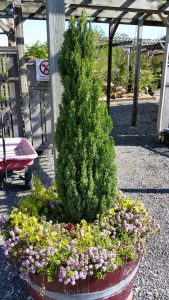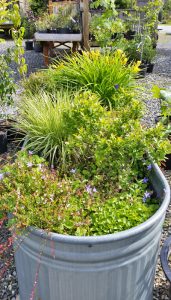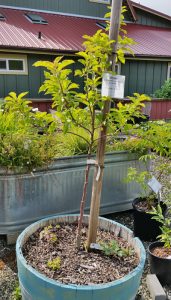We talk to many people these days that want to grow perennial and woody plants in containers. Maybe because they live in an apartment or condo, and don’t have a yard, or because they find it easier to manage. But growing plants in containers is actually a little trickier than growing in the ground. Some considerations:
Make sure the container is large enough for a mature plant. The container should be frost proof; some ceramic containers will crack if exposed to freezing and thawing. There are attractive plastic and fiberglass containers on the market today, but perhaps one of the best materials is wood. Cedar boxes and oak barrels make excellent patio planters. Galvanized stock tanks found at many farm stores also make good containers.
Potting:
It is best to use a coarse potting soil rather than garden soil in the container. It does not compact as readily as garden soil and provides more even moisture retention. One good brand of coarse potting soil that is somewhat readily available is Sunshine Mix #4 (Aggregate). You should plan on repotting your plants every 2-3 years during their dormant period ( late winter or early spring), replacing the potting soil with new potting soil. If you are putting the plant back into the same container, you should root prune at repotting to keep the root system dense.
Plants in containers prefer even moisture. This means checking the soil often and watering frequently. When you hand water, water in small amounts several times to make sure the soil is thoroughly moistened. We recommend investing in a patio drip system on a timer if you are not a reliable waterer.
The easiest way to fertilize container plants is to use a slow release fertilizer such as Osmocote. For organic fertilizing, mix bone meal or a complete all purpose organic fertilizer into your potting mix before planting, or use a liquid plant based fertilizer at a weak rate on a regular basis. It is better to under-fertilize rather than over-fertilize.
Soil Temperature:
In a container, soil temperatures fluctuate much more than in the ground. In the summer protect the pot from direct sun to keep the soil cool. The soil also gets much colder during winter cold spells. Many plants that are hardy planted in the ground can suffer winter damage in a pot because their roots get too cold. To prevent this kind of damage, you can move your plant into an unheated building for the winter, or move it close to your house. If it is too big to move, you can wrap the pot with insulation. Another method is to line the pot before planting. Some people place straw bales around their pots for winter protection.
Growing Woody Plants In Containers
One of the best groups of plants for containers are conifers. Many conifers are both extremely hardy and drought tolerant. Many pines (Pinus sp.)are hardy enough that their containers do not need winter protection. Other conifers that work well are true cedars (Cedrus), yews (Taxus), and junipers (Juniperus). Most of these conifers take well to pruning, and can be trained as large, artistic bonsai plants.
Japanese maples (Acer palmatum, Acer japonicum, Acer shirasawanum) are beautiful as container plants for decks. Be sure to choose a cultivar that is suitable for your light situation; all can take shade, but only a limited number can take full sun. The maples are very sensitive to drought, so
be careful with your summer watering. They also prefer cool soil in summer, so choose a light colored container, or make sure the container is shaded. Fertilize sparingly. Winter protect your maples.
You can also grow food plants in containers. Mini-dwarf apples can easily be grown in a whiskey barrel sized pot. Dwarf blueberries work well in containers, as do strawberries. Salad greens and herbs are also great in containers, although with shrubby herbs, pay attention to winter hardiness.
Almost any plant can be grown in a container if you follow the rules above. For containers that stay outside, a good rule of thumb on hardiness is this: a plant in an unprotected container is about 2-3 zones less hardy than in the ground. If you have a plant ground hardy to zone 6 in a container, its actual hardiness will be zone 8 or 9.




